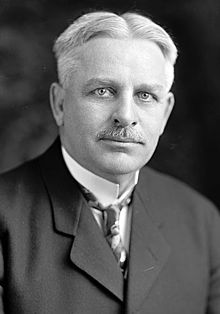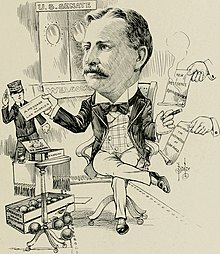Frank Flint
Frank Flint | |
|---|---|
 | |
| United States Senator from California | |
| In office March 4, 1905 – March 3, 1911 | |
| Preceded by | Thomas R. Bard |
| Succeeded by | John D. Works |
| Personal details | |
| Born | July 15, 1862 North Reading, Massachusetts, U.S. |
| Died | February 11, 1929 (aged 66) near Manila, Philippines |
| Resting place | Forest Lawn Memorial Park Cemetery Glendale, California, U.S. |
| Political party | Republican |
| Spouse |
Katherine J. Bloss (m. 1890) |
| Children | 2 |
| Occupation |
|
Frank Putnam Flint (July 15, 1862 – February 11, 1929) was a United States senator from California from 1905 to 1911.
Early life
[edit]Frank Putnam Flint was born on July 15, 1862, in North Reading, Massachusetts, to Althea Louise (née Hewes) and Francis Eaton Flint.[1][2][3] In 1869, his family moved to San Francisco, California, where he attended public schools. He had asthma. In 1888 he moved to Orange, then Los Angeles, California.[1]
Career
[edit]In 1888 or 1890, he was appointed a clerk in the United States marshal's office in Los Angeles, and began to study law. In 1892 he was appointed assistant United States attorney under Mathew Thompson Allen. In 1883 he resigned and formed a law partnership with Allen, Allen & Flint, which lasted two years until Allen became a judge.[1][4] In 1895, Flint and Donald Barker reformed the law firm as Flint & Barker. In 1897 Flint was appointed United States attorney for the southern district of California, and served four years. Flint was active in Republican politics.[4][5] He was a fruit-grower,[6] politician and banker.
In Los Angeles he was a member of the chamber of commerce and of its law committee; a member of the Municipal League, the Sunset club, the California club, the Union League club, the Republican league, the Masonic order and Knights Templar. He attended the Presbyterian church, was a trustee of Occidental College, a director of two banks (Equitable Savings, Los Angeles National).[7]

He served as United States Attorney for the Southern District of California from 1897 to 1901 and as a U.S. Senator from California from 1905 until 1911 as a Republican, and holds the distinction of being the 1000th senator in overall seniority.[8] Flint served one term in the Senate and did not seek reelection.
Flint was elected as president of the board of trustees of Occidental College in 1914.[9][10] Flint served as chairman of the National Boulder Dam Association and advocated for the building of the Boulder Dam (later renamed the Hoover Dam). In 1915, he became president of the Los Angeles Investment Company. He served in that role until his resignation in October 1928.[4][9]
Personal life
[edit]On February 25, 1890, he married Katherine J. Bloss in Los Angeles; and they had two children.[1] His brother Motley H. was postmaster of Los Angeles.[3] Flint lived on Flintridge Avenue in Pasadena. He was a majority stockholder of Flintridge Country Club, but in 1927 withdrew his stake.[4]
Flint died on February 11, 1929, aboard the S.S. President Polk near the harbor of Manila.[9] His body lay in state at Los Angeles City Hall. He was interred in the Forest Lawn Memorial Park Cemetery in Glendale.[11]
Legacy
[edit]
The city of La Cañada Flintridge, California, is named, in part, for him, as he was a developer of Flintridge, which merged with La Cañada in the late 20th century. As a senator from California, he played a great part in making the Mission style the official architectural style of government buildings in Southern California[citation needed] and played a major political role in bringing Owens Valley water to metropolitan Los Angeles.
See also
[edit]References
[edit]- ^ a b c d Shuck, Oscar T. (1901). History of the Bench and Bar of California. Clark, New Jersey: The Lawbook Exchange, Ltd. p. 1022. ISBN 9781584777069. Retrieved August 5, 2023.
- ^ "Mother of Frank Flint Succumbs". The Los Angeles Times. June 28, 1930. p. 13. Retrieved August 5, 2023 – via Newspapers.com.

- ^ a b "Flint Famed As Financier". The Pasadena Post. July 14, 1930. p. 1. Retrieved August 5, 2023 – via Newspapers.com.

- ^ a b c d "Frank Flint Dies Aboard Steampship". The Pasadena Post. February 12, 1929. p. 2. Retrieved August 5, 2023 – via Newspapers.com.

- ^ "Sketch of New Senator". Los Angeles Daily Herald. Vol. 32, no. 103. January 12, 1905. p. 2. Retrieved May 8, 2016.
- ^ Chapple, Joe Mitchell (March 1905). "Affairs at Washington". National Magazine. 21 (6): 586.
- ^ "Sketch of New Senator". Vol. 32, no. 103. Los Angeles Daily Herald. January 12, 1905. p. 2. Retrieved May 8, 2016.
- ^ https://www.senate.gov/artandhistory/history/resources/pdf/chronlist.pdf [bare URL PDF]
- ^ a b c "Flint Dies Aboard Manila Liner". The Pasadena Post. February 12, 1929. p. 1. Retrieved August 5, 2023 – via Newspapers.com.

- ^ "Occidental College Dedication". Los Angeles Times. February 19, 1914. p. 12. Retrieved August 5, 2023 – via Newspapers.com.

- ^ "Body of Flint to Lie in State". Los Angeles Evening Express. March 9, 1929. p. 3. Retrieved August 5, 2023 – via Newspapers.com.

External links
[edit]- United States Congress. "Frank Flint (id: F000207)". Biographical Directory of the United States Congress.
- Frank Flint at Find a Grave
- 1862 births
- 1929 deaths
- People from North Reading, Massachusetts
- Politicians from San Francisco
- Politicians from Los Angeles
- Occidental College people
- California Republicans
- Republican Party United States senators from California
- United States Attorneys for the Southern District of California
- 19th-century American lawyers
- 20th-century American lawyers
- 19th-century California politicians
- Burials at Forest Lawn Memorial Park (Glendale)
- 20th-century United States senators
- California politician stubs

